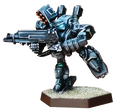Gila
The initial concept behind the Gila was to make a rapid and small Gear which could get into close range with other small and medium Gears, and chew them up.
While the Gila’s size is the same as the Iguana upon which it was based, the design team at Territorial Arms has gone out of its way to make the weapons load second to none for its size.
Also, in an attempt to compensate for its limited defenses, several improvements were incorporated with the intention of making the Gear tougher in close combat. Redundant systems for the sensors and fire control modules have ensured that the Gila could take almost any hit and still keep going at maximum efficiency. This required new levels of technology in miniaturization which were only available after the War of the Alliance, but even with smaller chips, there was still an increase in the volume of wiring and components, and little room to put it in.
Much time was spent on redesigning the Gila’s insides, engineers wracking their brains trying to gain cubic centimeters one at a time. In the end, the Gila became about as heavy as a Jäger even if it seemed much smaller. It had to be equipped with a special engine — a 440 Hp WV-850TC/X V-engine — and many of its structural beams had to be reinforced to compensate for the added weight.
The Gila’s armor was thickened to rival even that of the Black Mamba, turning the new design into, according to some, "some kind of armadillo monster." Lastly, the weapons were also shielded, ensuring once more that the Gear would actually make it to close range and survive there long enough to do some damage.
The payload was naturally very different from the basic Iguana. Whereas that Gear’s direct fire weapon was an MPGU-22 pack gun in the original design, the Gila’s requirements convinced the engineers to come up with a modification on the AK-67. The result, the AK-86, a Close Assault Weapon System featuring a heavy autocannon with an underslung fragcannon, is sure to pack a heavy punch. The Gila has also been specially fitted with a forward-mounted light flamer on it's waist. The Vogel-6 Rocket Pod was removed and replaced by a HARGON-C Rocket Launcher.
Usage
The Gila’s prototype first round of test performances have been very positive. Movement and firepower have provided results well within the expected requirements. While all of the results have yet to be processed and analyzed, it appears that only a few minor problems have crept into the prototype, and most of them should be easy to fix. For one thing, technicians have frequently reported a series of electrical malfunctions, including erratic control response, dual signals or delayed processing. This has caused problems with the sensors and the multi-target tracking capabilities of the Gear, but not to an extent that worries the design team.
Additionally, because of the compact and redundant electronic systems, the Gila has a somewhat more pronounced radar signature and is this more easily locked onto by enemy vehicles. This second design flaw has been a cause for worry for the engineers, who were explained by pilots that a lock-on is often a prelude to death, and who see this as a serious problem. Efforts are now being made to design some sort of shielding to help mask these emissions. Naturally, because of the inherent complexity of the Gila’s design, making any kind of modifications on it is extremely difficult and the maintenance costs of the Gear are expected to be very high.
Pilots have had no serious problems with the controls of the Gila, which are surprisingly efficient and easy to learn. It was noticed, however, that female pilots found the Gila significantly easier to pilot than their male counterparts. It has been surmised that it could be due to the size problems, many bulkier men finding the confinement unpleasant. This is not something which is as frequent in the Iguana and other similarly compact models, and Territorial Arms has begun to wonder if there could be something more to it than just a casual and meaningless preference by the Gear's template Neural Network. The company has just recently put together an investigation team in the hopes that this could perhaps lead to an improved pilot-machine relationship.
In any case, the test pilots themselves think nothing of it and assume that this is just one of those natural preferences which have little or no bearing on reality. Some were quoted "If Territorial Arms executives want to throw their money to the white sands, that’s their problem".
Gallery
| Units | |||||||||||||||||||||||||||||||||||||||||||||||||||||||||||||
|---|---|---|---|---|---|---|---|---|---|---|---|---|---|---|---|---|---|---|---|---|---|---|---|---|---|---|---|---|---|---|---|---|---|---|---|---|---|---|---|---|---|---|---|---|---|---|---|---|---|---|---|---|---|---|---|---|---|---|---|---|---|
| Terra Nova |
| ||||||||||||||||||||||||||||||||||||||||||||||||||||||||||||
| Earth |
| ||||||||||||||||||||||||||||||||||||||||||||||||||||||||||||
| Caprice |
| ||||||||||||||||||||||||||||||||||||||||||||||||||||||||||||
| Utopia |
| ||||||||||||||||||||||||||||||||||||||||||||||||||||||||||||
| Eden |
| ||||||||||||||||||||||||||||||||||||||||||||||||||||||||||||

